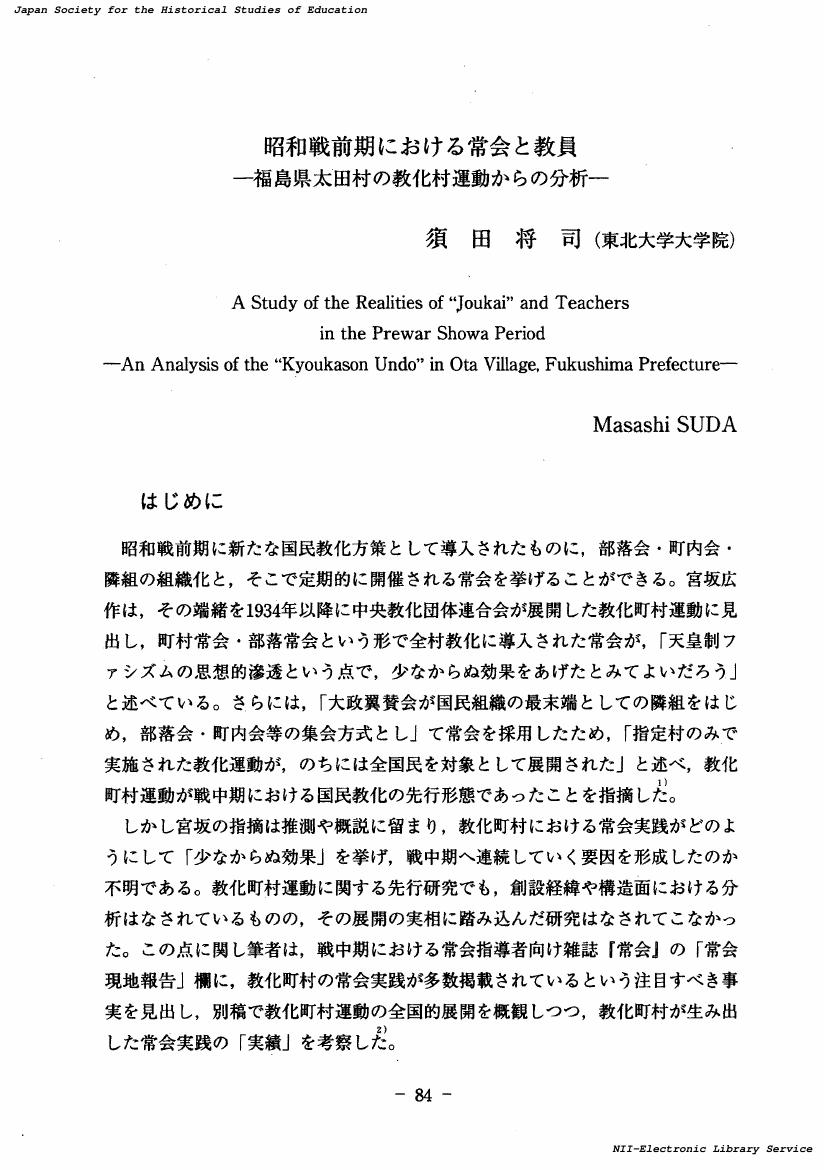7 0 0 0 OA 日中戦争期における「学校常会」論の広がり
- 著者
- 須田 将司
- 出版者
- 教育史学会
- 雑誌
- 日本の教育史学 (ISSN:03868982)
- 巻号頁・発行日
- vol.59, pp.032-044, 2016 (Released:2017-04-03)
- 参考文献数
- 16
During the Second Sino-Japanese war (1937-1941), there was an expansion of discourse and practice of “School Meetings” (gakko jokai), a term that here encompasses “Pupil Meetings” and “Children’s Neighborhood Groups.” This paper explores the trend of “School Meetings” discourse and its significance as a new method of drilling and training.Specifically, this paper analyzes the formation and development of this discourse and practice by focusing on the “Federation for Citizen Disciplinary Education” (Kokumin Kun’iku Renmei) and the “Japan Young Teachers Association” (Nihon Seinen Kyoshidan).In December, 1940, the “Federation for Citizen Disciplinary Education” held a workshop, inviting pioneering practitioners and theorists of “Morals Education” (hotoku kyoiku), thereby directly absorbing their know-how and theory. Thereafter, within the Federation, the practises that encourage children’s “virtues and merits” through “School Meetings,” and emphasize approach to the children’s inner side with “responsibility and compassion” were increased.As for, the “Japan Young Teachers Association” developed the theories and practices of “School Meetings” through connections with policy strategists. Their methods emphasized having a “cooperative heart” and practicing “self-reflection” as well as the importance of “public service” and “drilling.”“School Meetings” generated from the two “breeding grounds” both evoked “spontaneity” and “initiative” through “self-reflection” while removing self-assertion. This was inextricably linked to stifling feelings of children who were not committed themselves to drilling. The movement may be said to have exposed the limits of pedagogy.
- 著者
- 渡部 晃平 須田 将崇 福富 宏和
- 出版者
- 日本甲虫学会
- 雑誌
- さやばねニューシリーズ = Sayabane N.S (ISSN:21859787)
- 巻号頁・発行日
- no.27, pp.6-12, 2017-09
2 0 0 0 OA 血管内皮細胞老化について
- 著者
- 須田 将吉 清水 逸平 南野 徹
- 出版者
- 一般社団法人 日本血栓止血学会
- 雑誌
- 日本血栓止血学会誌 (ISSN:09157441)
- 巻号頁・発行日
- vol.30, no.3, pp.521-528, 2019 (Released:2019-06-14)
- 参考文献数
- 19
要約:老化は様々な疾患のリスク因子である.動脈硬化巣に老化細胞が蓄積していることがわかり,血管細胞の老化がこれらの疾患に関与していることが示された.血管内皮細胞特異的に老化を抑制すると血管機能が保たれ,反対に老化を促進すると血管機能が悪化することも報告されている.さらに血管内皮細胞の老化抑制は,脳血管・心血管疾患だけでなく,肥満や糖尿病も改善させることが明らかとなり,血管内皮細胞の老化抑制は加齢関連疾患の包括的治療につながる可能性が示唆されている.さらに近年では,老化細胞除去(senolytic)治療という新しいストラテジーに注目が集まっている.老化した血管内皮細胞を選択的に除去する薬剤を投与したマウスでは,認知症や加齢による筋力低下などの老化の表現型が改善し,さらには寿命が延長するという結果も出てきている.血管内皮細胞老化は,血管疾患だけでなく様々な疾患の発症や個体老化にも重要であり,新しい治療標的となりつつある.
1 0 0 0 血管内皮細胞老化について
- 著者
- 須田 将吉 清水 逸平 南野 徹
- 出版者
- 一般社団法人 日本血栓止血学会
- 雑誌
- 日本血栓止血学会誌 (ISSN:09157441)
- 巻号頁・発行日
- vol.30, no.3, pp.521-528, 2019
<p><b>要約:</b>老化は様々な疾患のリスク因子である.動脈硬化巣に老化細胞が蓄積していることがわかり,血管細胞の老化がこれらの疾患に関与していることが示された.血管内皮細胞特異的に老化を抑制すると血管機能が保たれ,反対に老化を促進すると血管機能が悪化することも報告されている.さらに血管内皮細胞の老化抑制は,脳血管・心血管疾患だけでなく,肥満や糖尿病も改善させることが明らかとなり,血管内皮細胞の老化抑制は加齢関連疾患の包括的治療につながる可能性が示唆されている.さらに近年では,老化細胞除去(senolytic)治療という新しいストラテジーに注目が集まっている.老化した血管内皮細胞を選択的に除去する薬剤を投与したマウスでは,認知症や加齢による筋力低下などの老化の表現型が改善し,さらには寿命が延長するという結果も出てきている.血管内皮細胞老化は,血管疾患だけでなく様々な疾患の発症や個体老化にも重要であり,新しい治療標的となりつつある.</p>
1 0 0 0 OA スターリンの大テロルとウズベキスタン共産党
- 著者
- 須田 将
- 出版者
- 北海道大学スラブ研究センター
- 雑誌
- スラブ・ユーラシア研究報告集
- 巻号頁・発行日
- vol.5, pp.172-193, 2012-11
中央ユーラシア研究を拓く: 北海道中央ユーラシア研究会第100回記念. 北海道中央ユーラシア研究会編
1 0 0 0 IR スターリンの大テロルとウズベキスタン共産党
- 著者
- 須田 将
- 出版者
- 北海道大学スラブ研究センター
- 雑誌
- スラブ・ユーラシア研究報告集
- 巻号頁・発行日
- no.5, pp.172-193, 2012-11
北海道中央ユーラシア研究会 第100回記念大会. 第1部 報告4. ISBN: 9784938637736
1 0 0 0 OA 中央教化団体連合会刊・雑誌『常会』(1939-1944)の所蔵状況・目次一覧
- 著者
- 須田 将司
- 出版者
- 東洋大学
- 雑誌
- 東洋大学文学部紀要. 教育学科編 (ISSN:13474960)
- 巻号頁・発行日
- vol.44, pp.19-57,
1 0 0 0 OA 昭和戦前期における常会と教員 : 福島県太田村の教化村運動からの分析
- 著者
- 須田 将司
- 出版者
- 教育史学会
- 雑誌
- 日本の教育史学 (ISSN:03868982)
- 巻号頁・発行日
- vol.46, pp.84-103, 2003-10-01 (Released:2017-06-01)
1 0 0 0 OA 昭和戦前期「報徳教育」の錬成的・教育学的展開に関する実証的研究
1 0 0 0 IR 都道府県・旧植民地教育会雑誌 所蔵一覧
- 著者
- 梶山 雅史 須田 将司
- 出版者
- 東北大学大学院教育学研究科
- 雑誌
- 東北大学大学院教育学研究科研究年報 (ISSN:13465740)
- 巻号頁・発行日
- vol.54, no.2, pp.445-487, 2006-06
